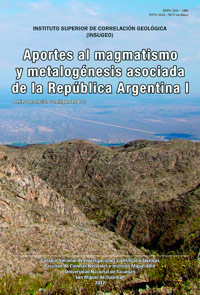Serie Correlación Geológica 28 (1)
Geoquímica y metalogénesis de las pegmatitas y granitos asociados del sector sur del distrito Comechingones, Córdoba
Eugenio Aragón | Jorge E. Coniglio | Fernando J. D'eramo | Manuel Demartis | María Natalia Maffini | Hugo A. Petrelli | Lucio. P. Pinotti
Descargar trabajo en formato PDFResumen
El distrito pegmatítico Comechingones, ubicado en el faldeo oriental de la sierra homónima, en la provincia de Córdoba, involucra pegmatitas graníticas correspondientes a la clase de Elementos Raros, tipo berilo, subtipo berilo-columbita-fosfatos, algunas en transición a la clase muscovítica, con mineralizaciones de Be-Nb- Ta-U y minerales industriales. Dos tipos de pegmatitas graníticas han sido descriptas en el sector sur del distrito: pegmatitas tipo I, con tamaños que en total pueden alcanzan los 1000 metros de longitud y superar los 50 de ancho, internamente zonadas y portadoras de Be, Nb-Ta y U; y pegmatitas tipo II, de menores dimensiones, no zonadas, ricas en cuarzo de alta pureza, carentes de mineralizaciones metalíferas, y asociadas espacial y genéticamente con leucogranitos aplíticos. En este trabajo se presentan y discuten los datos geoquímicos preliminares de ambos tipos de pegmatitas y granitos asociados. Los datos geoquímicos obtenidos, apoyados con descripciones de campo y petrográficas, permiten establecer que las dos tipologías de pegmatitas corresponden a dos eventos magmáticos diferentes (muy probablemente diacrónicos). El primero generó las pegmatitas tipo I, las cuales de sur a norte presentan un aumento en el grado de fraccionamiento desde pegmatitas poco evolucionadas y sin mineralizaciones de elementos raros, hasta pegmatitas evolucionadas con depósitos metalíferos de interés económico. El segundo evento dio origen a las pegmatitas tipo II y a los granitos aplíticos, y carece de especialización metalogenética, evidenciado por los indicadores de diferenciación magmática sistemáticamente inferiores a los de las pegmatitas tipo I y a la carencia de mineralizaciones metalíferas.
Abstract
GEOCHEMICAL AND METALLOGENETICAL STUDY OF THE PEGMATITES AND ASSOCIATED GRANITES FROM SOUTHERN COMECHINGONES PEGMATITIC FIELD, CÓRDOBA. The Comechingones pegmatitic field (CPF) is located in the eastern flank of the Sierra de Comechingones, Córdoba province. It is composed of granite pegmatites belonging to the Rare-Element class, beryl type, beryl-columbite-phosphate subtype; some of them are transitional into the Muscovite class. Beryllium, Nb, Ta and U deposits, as well as high-quality industrial mineral deposits, are frequently associated with these pegmatites. In the southern part of the CPF two different pegmatite types have been described. Type I pegmatites constitute large zoned bodies with up to 1000 m long and 50 m thick, and may constitute rare element deposits, whereas type II pegmatites occur as small, unzoned quartz-rich dykes, without metalliferous mineralizations, spatial and genetically associated with aplitic leucogranites. Preliminary geochemical data from both pegmatites types and granites are presented and discussed in this contribution. Geochemical evidences, supported by field and petrographic observations, suggest that the two types of pegmatites identified in the study area represent two different, probably diachronic, magmatic stages. Type I pegmatites display a geochemical gradation in a S-N direction, from barren pegmatites in the south to fractionated pegmatites in the northern part of the study area, and are the lithological product of the first magmatic stage. The second stage lead to the crystallization of aplitic granites and barren type II pegmatites, geochemically less fractionated than type II pegmatites.






